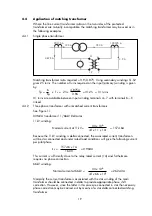
14
2 multimeters
Double pole switch
Single pole switch
MMLB01 test plug
MMLB02 single finger test plug
8A variable auto-transformer
2 Variable resistors 0 – 100 Ohms, suitably rated
Diode rated 7A for magnetising inrush test, if required.
Note:
The following test instructions are based on injecting current directly into the
relay terminals, however if a MMLG test block is incorporated in the scheme,
then it is more convenient to inject current into the MMLG test block. Refer to
the relevant scheme diagram for connections.
3.2.2
DC auxiliary supply
Check the rated auxiliary voltage Vx on the front plate and connect a suitable
smoothed dc supply or station battery supply to relay terminals 13(+ve) and 14(–ve).
3.2.3
Relay settings
Connect the overcurrent test set to the relay as shown in Figure 1. Adjust the relay
front panel switches to give a relay setting
I
s = 0.1 x
I
n (10% setting,
I
n = relay
rated current).
Slowly increase the current until the relay operates, indicated by a light emitting
diode (led) on the front plate. Note the operate (differential) current and check that
this is within
±
10% of the expected current (ie. 0.09 to 0.11A for a 1A relay, or
0.45 to 0.55A for a 5A relay, with a 10% relay setting).
Check that the relay trip contacts (terminals 1,3 and 2,4 ) are closed with the current
above the setting, and that these contacts open as the current is removed.
Check also that the relay alarm contacts (terminal 9,11) are closed with the current
above the setting and remain closed as the current is removed.
Press the reset button on the relay front plate and check that the LED indicator resets
and that the alarm contacts open.
Repeat the test with the relay adjusted to settings of 0.2 x
I
n, 0.3 x
I
n, 0.4 x
I
n and
0.5 x
I
n in turn. Check that the settings are within
±
10% of the nominal value.
Notes:
1. The setting may also be checked using a variable auto-transformer,
0 – 100 Ohm resistor and ammeter, as an alternative to using an
overcurrent test set.
2. During commissioning do not disconnect the dc auxiliary supply
without first removing the ac operating current, otherwise the trip
contacts on terminals 1,3 and 2,4 may remain operated.
If this does occur the contacts may be reset by removing the ac
operating current, and then switching on the dc auxiliary supply at rated
voltage.
3. It is prudent to switch off the dc supply before inserting or removing
modules.
If MMLG Test Block
is supplied
}










































